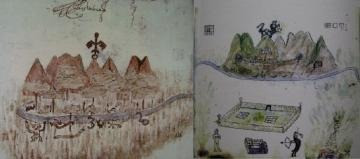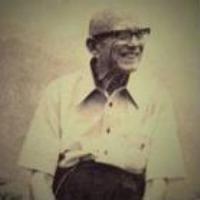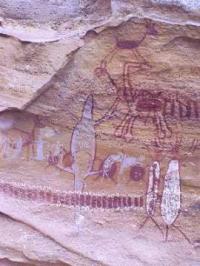Copy Link
Add to Bookmark
Report
EJournal Volume 01 Number 03

BABYL OPTIONS:
Version: 5
Labels:
Note: This is the header of an rmail file.
Note: If you are seeing it in rmail,
Note: it means the file has no messages in it.
1,,
Received: from uacsc2.albany.edu by aramis.rutgers.edu (5.59/SMI4.0/RU1.5/3.08)
id AA25899; Tue, 5 Jan 93 15:58:53 EST
Message-Id: <9301052058.AA25899@aramis.rutgers.edu>
Received: from ALBNYVM1 by UACSC2.ALBANY.EDU (IBM VM SMTP V2R2)
with BSMTP id 0680; Tue, 05 Jan 93 15:58:27 EST
Received: from ALBNYVM1.BITNET by ALBNYVM1 (Mailer R2.08) with BSMTP id 9017;
Tue, 05 Jan 93 15:58:23 EST
Date: Tue, 5 Jan 1993 15:58:23 -0500
From: Revised List Processor (1.7e) <LISTSERV@uacsc2.albany.edu>
Subject: File: "EJRNL V1N3"
To: David Pirmann <pirmann@cs.rutgers.edu>
*** EOOH ***
Date: Tue, 5 Jan 1993 15:58:23 -0500
From: Revised List Processor (1.7e) <LISTSERV@uacsc2.albany.edu>
Subject: File: "EJRNL V1N3"
To: David Pirmann <pirmann@cs.rutgers.edu>
_______ _________ __
/ _____/ /___ ___/ / /
/ /__ / / ______ __ __ __ ___ __ ___ _____ / /
/ ___/ __ / / / __ / / / / / / //__/ / //__ \ / ___ \ / /
/ /____ / /__/ / / /_/ / / /_/ / / / / / / / / /__/ / / /
/______/ /______/ /_____/ /_____/ /_/ /_/ /_/ \___/_/ /_/
November 1991 _EJournal_ Volume 1 Issue 3 ISSN 1054-1055
An Electronic Journal concerned with the implications
of electronic networks and texts.
University at Albany, State University of New York
ejournal@albnyvms.bitnet
There are 873 lines in this issue.
CONTENTS:
Oral Knowledge, Typographic Knowledge, Electronic Knowledge: 686 lines.
Speculations on the History of Ownership
by Doug Brent
Faculty of General Studies
University of Calgary
DEPARTMENTS:
Letters (policy) 10 lines.
Reviews (policy) 10 lines.
Supplements to previous texts (policy) 11 lines.
Information about _EJournal_ (subscribing, etc.) 45 lines.
PEOPLE: Board of Advisors, Consulting Editors
-------------------------------------------------------------------------------
This electronic publication and its contents are (c) copyright 1991 by
_EJournal_. Permission is hereby granted to give away the journal and its
contents, but no one may "own" it. Any and all financial interest is hereby
assigned to the acknowledged authors of individual texts. This notification
must accompany all distribution of _EJournal_.
-------------------------------------------------------------------------------
About back issues: They are available from Albany's bitnet Fileserver. The
message INDEX EJRNL sent to LISTSERV@ALBNYVM1.BITNET will trigger an up-to-
date readout of what is available -- including the file EJRNL INDEX.
Addresses: Please note the difference between the IBM ("VM1"), where Bitnet
server functions occur, and the Digital Equipment VAX ("VMS"), where our
"office" resides.
To accomplish (for example): Send to: Message:
Getting the back-issue index LISTSERV@ALBNYVM1 INDEX EJRNL
Getting Vol 1 Number 1 LISTSERV@ALBNYVM1 GET EJRNL V1N1
Subscribing to _EJournal_ LISTSERV@ALBNYVM1 SUB EJRNL Your Name
Mailing a message EJOURNAL@ALBNYVMS Your message....
Suggestions about smoothing the relationships among readers, the journal, the
medium (and libraries) are always welcome. So are texts for consideration by
the editors.
-------------------------------------------------------------------------------
Oral Knowledge, Typographic Knowledge, Electronic Knowledge:
Speculations on the History of Ownership
by Doug Brent
Faculty of General Studies
University of Calgary
1. Using Transformation Theory
It has frequently been observed that computers are revolutionizing the concept
of knowledge ownership. Old standards of copyright and the ownership of
intellectual property simply do not apply to the universe of knowledge in
cyberspace. In this article I wish to examine more closely the ways in which
concepts of intellectual property are changing as the computer changes our
relationship to knowledge.
The main tool I wish to use in this investigation is the cluster of theories
that Michael Heim has dubbed "transformation theory" (_Electric Language_
1987). Marshall McLuhan first called attention to the transforming powers of
media in his insightful and infuriating books, particularly his masterpiece
_Understanding Media_ (1964). In that book, he claims that we cannot learn
anything of importance about a medium by looking only at its content:
Our conventional response to all media, namely that it
is how they are used that counts, is the numb stance of
the technological idiot. For the "content" of a medium
is like the juicy piece of meat carried by the burglar
to distract the watchdog of the mind. (p. 18)
To avoid that numbness, we must refocus our attention on the ways in which the
technological characteristics of the medium itself reshape our lives not just
by giving us new tools to play with but by reshaping our consciousness on a
fundamental and subliminal level.
In _Orality and Literacy_ (1982), Walter Ong builds on McLuhan's general
philosophy, plus anthropological research on the development of oral societies,
in order to explain the dramatic changes in society that came about with the
advent of literacy. Ong argues that the shift from oral to literate culture in
about the fifth century B.C. did more than change patterns of art, politics and
commerce. It enabled a profound shift in human conscious, bringing about the
linear, abstract forms of Western logic that we take for granted today but
which were simply unthinkable without literacy as a means of preserving
complicated original thought. [line 42]
What makes transformation theory a particularly powerful tool for speculating
on the impact of computers is that the information revolution intuitively feels
like a third stage in this process, a revolution as great as the shift from
orality to literacy. Admittedly, Heim warns severely against extending the
transformation theory developed to deal with the first revolution and facilely
using it to predict the outcome of the second:
Because it is anchored in the difference between orality
and literacy, the transformation theory is unsuited for
an investigation of word processing. Constant reference
to the emergence of literacy distorts the phenomenon by
reducing the emergence of word processing to a new kind
of literacy. The use of the metaphor from print culture
is understandable when we are confronted by the profound
novelty of digital writing. But if we lose sight of the
weakness of the metaphor, we shall pass right by the
phenomenon in our anxiety to treat it easily in a
familiar, conventionally manageable way. (p. 113)
Heim's warning is well taken; the second shift is neither simply an extension,
nor simply a reversal (despite what I am about to argue) of the first. Yet if
historical study is to be justified on any grounds other than idle curiosity,
it surely must be on the grounds that we can learn something about the present
and future by extrapolating from the past. The important caveat is that we
must not depend only on a metaphor. To the extent that we see echoes of the
first communications revolution in the second, we must be careful to use the
metaphor of the first transformation only as a means of generating suggestive
possibilities. Before we can rely on these suggestions even provisionally, we
must corroborate them by close examination of changes in personal and social
behaviour that are already sufficiently far along to be susceptible of
examination.
2. Ownership of Knowledge in Oral Societies
Ong claims that in a primary oral culture--that is, a culture that has never
known literacy--knowledge is not owned; rather it is performed. Without print,
knowledge must be stored not as a set of abstract ideas or isolated bits of
information, but as a set of concepts embedded deeply in the language and
culture of the people. Strictly procedural knowledge--how to build a boat, how
to fight a war--is passed on directly from craftsman to craftsman through the
process of apprenticeship. However, the more abstract knowledge of the
tribe--not just their history but also their values, their concepts of justice
and social order--is contained in the epic formulae, recurrent themes, and
mythic patterns, plots and stereotypes out of which the storytellers of the
tribe weave their narratives. This knowledge exists as a pre-existing network
of knowledge, interconnected in extraordinarily complex and non-linear ways and
all known in at least its broad outlines to the storyteller's audience before
he begins (see Bolter, _Writing Space_, 1991). [line 91]
Lord's work with modern illiterate poets underlines the implications of this
means of transmitting knowledge (_The Singer of Tales_, 1960). Although the
storytellers usually insist that they tell their stories exactly the same way
each time, transcriptions of stories told by modern oral storytellers reveal
significant variation. Rather than memorizing a verbatim "text," as literate
observers assumed, the storytellers fit stock elements to a rhythmic pattern
and a well-known plot to re- produce the story anew each time it is told.
There simply is no "text" apart from each individual incarnation of each tale.
This has implications for how the creative act is seen. If oral performers
were simply memorizing and reciting a work that had at one time been "composed"
by a single individual, the process would be no more than an oral version of
literate composition, in which a text is composed once and reproduced
mechanically many times. But Lord's work reveals that the performer of a tale
is combining an act of creation with an act of transmission. His primary work
is to transmit the culture of the tribe, and in this act of transmission he
must be conservative. Changes in oral knowledge cannot be undone, for there
are no old copies to go back to. The tellers must therefore be able to
reproduce the forms and plots in which their tribe's knowledge is contained as
faithfully as possible. Yet there is also a gradual drift in the stories. In
a process that Ong calls "homeostasis," the stories change imperceptibly over
time to suit the needs and values of the culture as that culture changes. If
the values that are held in high regard by the culture shift to suit changing
circumstances, the heroes in the tales will acquire new characteristics, or
even cease to be heroes. Individual creativity is profoundly rhetorical, for
it is the subtle interplay between teller and audience that shapes the tales to
match the values of that audience; yet it is also largely invisible (Ong 1982).
[line 120]
This inseparability of creativity and performance meant that there was no such
thing as ownership of knowledge--or, more aptly, there was no such thing as
_private_ ownership of knowledge. Knowledge was held in common, entrusted to
the tellers of tales who were maintained by the tribe, not for their individual
contributions to the growth of ideas, but for their ongoing duty to keep
knowledge alive by performing it.
3. Ownership of Knowledge in Literate Societies
With the introduction of writing, all of this changed. According to Ong and his
anthropological school of communications history, writing had a number of
profound effects, including the development of the self-conscious, rational
self, of the power of abstraction, and consequently of the entire Western
system of logic. For my purposes here, however, the most important result of
the invention of writing was a separation of text and performance, of knowledge
and knower. As Havelock puts it in _Origins of Western Literacy_ (1976),
writing separates "the knower from the known" by creating a fossilized text
that can achieve a continued existence apart from any knower. The knowledge
represented by an oral tale is so embedded in mind and action that it cannot be
contemplated as a separate entity; such knowledge travels as an almost
subliminal partner of a performance, as transmission that the performer does
not even think of as "knowledge" but rather as simply a set of actions. A
manuscript, however, can be handled, stored, retrieved from a vault and
re-performed a millennium after all previous readers have died. Therefore,
with writing knowledge comes to be seen as something reified, as existing
outside the self.
If knowledge can be separated from the knower, it can be owned by separate
individuals. In an oral culture, plagiarism is unthinkable, simply because the
survival of the culture depends on plagiarism--that is, on each performer
learning what has gone before and making it his own. As the manuscript society
came into existence, it became more common to attribute written tales to their
sources in prior texts. Yet, as any student of early written poetry will know
(Chaucer is a well-known example), prior texts were often so inseparably
mingled with new material that generations of scholars have been kept happily
employed in sorting them out. During the manuscript age, the painstaking
copying and illustrating of a manuscript was in some respects a personal
performance of knowledge analogous to the performance of an epic poem or folk
tale.
[line 160]
It was the printing press that made private ownership of knowledge a necessity,
for it was the printing press that finally severed the connection between the
creation and the transmission of knowledge. For transmission was now a
mechanical act, performable by a machine. Originality, once a deadly danger to
a society that had to struggle to maintain its equilibrium, could now be seen
as more valuable than performance. To claim originality for what was only a
re-performance became a serious breach of the values of the society.
Appropriating another's ideas, once an essential means of keeping them alive,
became the act of a _plagiarius_, a torturer, plunderer, oppressor:
Typography had made the word a commodity. The old
communal oral world had split up into privately claimed
freeholdings. The drift toward greater individualism
had been served well by print. (Ong 1982, p. 131)
Copyright laws were soon created as a means of preserving this intellectual
property. As Patterson points out (_Copyright in Historical Perspective_
1968), copyright was originally created more as a means of breaking the
stationers' monopoly on texts than as a means of protecting authors' rights.
Yet the commonsense notion that an author's words were things of countable
value pressed the law of copyright further and further in the direction of
articulating those rights against those of the stationers who simply reproduced
the physical text. By the eighteenth century, copyright was firmly established
not only as a means to ensure that an author will be paid for his ideas, but
also to ensure that he will be able to protect their integrity by granting him
the sole authority to correct, amend or retract them. In the Miller vs. Taylor
decision of 1767, a decision vital to the shaping of English copyright law into
its final modern form, Mr. Justice Aston commented, "I do not know, nor can I
comprehend any property more emphatically a man's own, nay, more incapable of
being mistaken, than his literary works" (Patterson p. 170).
The modern abhorrence of plagiarism, of course, has never meant that one should
not use another's ideas. The practice of bringing ideas forward and
integrating them into later works is fundamental to the modern belief that
knowledge is cumulative and improvable. But a crucial difference between oral
and literate diffusion of knowledge is that as knowledge diffuses through
knowledge networks of modern research disciplines, it leaves behind the tracks
of its passage in the form of earlier texts linked by webs of citations. Among
other functions, these citations ensure that the producer of a particularly
fertile idea is given due credit for her work, even as that work is being
corrected, amended, extended, and ultimately submerged into the new knowledge
that is being built upon it. Whereas the oral bard could demonstrate that he
was earning his keep simply by continually re-performing the knowledge of which
he was guardian, the modern researcher must demonstrate that she is worthy of
being maintained by her tribe by creating work worthy of being explicitly cited
by others. Thus she retains ownership of the ideas at the same time as she
releases them into the world to perform their work--in a sense leasing rather
than transferring them to others. [line 209]
Thus the effects of printed texts are somewhat paradoxical. On the one hand,
the explicit pointers to earlier texts reinforce the fact that knowledge is
built communally, through the interactions of thousands of individuals. On the
other hand, the fact that each idea can be labelled with the name of its maker
has created the romantic myth of the individual creative genius. This myth
manifests itself in the arts as the figure of the brooding artist creating in
solitude, and in the sciences as the individual inventor, the Nobel prize
winner who sees what no-one has seen before.
4. Ownership of Knowledge in Cyberspace
In this context, then, what might the second shift, from print to the
electronic space afforded by word processing, computer conferencing, and
hypertext, do to our sense of the ownership of knowledge?
One of the most important features of typography, if we believe McLuhan and his
followers, is metaphorical. Here we are not talking about the investigator's
use of metaphor to extend the past into the future, the metaphor that Heim is
so reluctant to pursue. We are talking about an entire culture's metaphorical
transfer of characteristics of its communications medium to other aspects of
the culture. McLuhan suggests, for instance, that the reproduction of texts
from straight rows of exactly repeatable, individually meaningless units of
type is an amazingly close analogue of, and perhaps the model for, the
specialized industrial society in which an entire economy is assembled out of
small bits of individually owned private property--including intellectual
property. These sorts of speculation can be taken to the giddy heights of
unprovable assertion that McLuhan is justly derided for. Yet if we accept
provisionally that the medium can sometimes be the metaphor, we can perhaps
learn something about the effects of the second transformation by looking at
the metaphorical ways in which it allows us to conceptualize knowledge.
[line 241]
One of the most important ways in which the electronic metaphor operates is not
so much to change what writers do when they build knowledge, but rather to make
this process more immediately and more obviously _visible_ through the types of
operations which it allows and the physical steps which the writer goes
through. It has, after all, been observed for some time that the myth of the
individual discoverer of knowledge is exactly that--a myth. Perhaps the best
summary of this literature is Karen Burke LeFevre's _Invention as a Social Act_
(1987), a work that brings together accounts of collaborative invention from
postmodern literary theory, language philosophy and social psychology to argue
for a new emphasis on collaboration by writing teachers. One of the most
important of these sources is Michel Foucault:
[Foucault] describes the beginning of a discourse as a
re-emergence into an ongoing, never-ending process: "At
the moment of speaking, I would like to have perceived a
nameless voice, long preceding me, leaving me merely to
enmesh myself in it. . . . There would have been no
beginnings: instead, speech would proceed from me, while
I stood in its path--a slender gap--the point of its
possible disappearance." Elaborating on this
perspective, one may come to regard discourse not as an
isolated event, but rather a constant potentiality that
is occasionally evidenced in speech or writing. . . .
Such perspectives suggest that traditional views of
an event or act have been misleading when they have
presumed that the individual unit--a speech or a written
text, an individual hero, a particular battle or
discovery--is clearly separable from a larger,
continuing force or stream of events in which it
participates. For similar reasons Jacques Derrida has
criticized literary theories that attempt to explain the
meaning of a text apart from other texts that precede
and follow it. (p. 41-42)
Sociologists of science support this conception of knowledge as communal rather
than individual. Diana Crane's seminal study _Invisible Colleges_ (1972), for
instance, documents the extent to which ideas are nourished and developed
through networks of interaction among scientists who may come from many
different "official" disciplines but who form a powerful social group around a
common problem. Yet the print technology through which this
communally-developed knowledge is typically delivered-- distanced, fossilized,
abstracted from the network of interconnected minds that formed it--continually
enforces the opposite message. The metaphorical meaning of print technology is
isolation, not communality. In particular, the ability to claim one's
particular share of the intertextual web and stamp it with one's own name--an
ability made possible by the same printing press that made widespread
cumulation of knowledge possible as well--suggests that knowledge is
individually owned. [line 290]
I believe that computer mediated communication provides a totally different
metaphorical message, one that can take theories of collaborative knowledge out
of the realm of language philosophy and stamp them indelibly in the
consciousness of the entire society. Let us begin by looking at what is now
the most mundane aspect of computer-mediated communication, word processing.
Remember that one of the most important psychological effects of writing in
general and the printing press in particular is the fossilization of text as an
exteriorized object. However, composing on a word processor divides the
production of the text into two distinct stages. Ultimately the text issues in
a final stage of more or less complete closure, once a "final" draft is
published in a hard codex. But the word processor greatly extends the fluid
stage of text, abolishing the sense of discrete drafts and smaller divisible
units (pages) and turning the text into a long continuous document, a scroll
examined through a twenty-five line sliding window. Although this small window
can be a problem for students who cannot always visualize the entire text as a
unit (see for instance Richard Collier, "The Word Processor and Revision
Strategies," 1983), expert writers generally lose their dependence on what they
can see on the screen and internalize the sense of a text that exists in an
infinitely mutable state. Even the printout, apparently hard and immutable,
comes to be seen as purely provisional, for a new one incorporating changes can
be produced at whim.
A key aspect of this form of text is that it can easily be recombined with
other texts. Skilled writers who use word processors are well aware of how
often they cannibalize their own older texts for quotations, well-turned
paragraphs, ideas cut out of drafts and saved for future works in which they
might be more appropriate. But this effect does not become truly significant
until the writer's own text begins to interact with other sources of text
available on-line. The word processor is often seen as a preliminary stage of
conferencing, for posted text is often prepared initially on some kind of word
processor (whether PC or mainframe editor). However, this metaphor can be
reversed: the word processor is coming to be fed by on-line information as much
as the reverse. As other sources of text become available in machine-readable
format--texts received through electronic conferences and on-line publications,
texts downloaded from databases, et cetera--the awareness of intertextuality
that LeFevre speaks of becomes increasingly objectified, its implications
increasingly unmistakable. [line 328]
As I prepare this article I am conscious of two kinds of sources. Some of the
sources came to me in hard copy; the labour of typing quotations in by hand, of
leafing through separate texts to identify key passages, for me emphasises
their separateness, the claim of the original author over the knowledge. Other
sources came to me electronically; these I can cut and paste into my document
much more freely, integrating not just another's words but ultimately his very
keystrokes into my own construct. A well-trained scholar, I am always careful
to acknowledge, always careful not to place my own stamp of ownership on the
words of another. But the sliding together of texts in the electronic writing
space, texts no longer available as discrete units but as continuous fields of
ideas and information, is so much easier in electronic space--not just
physically easier but psychologically more natural-- that it is significantly
more effort to keep the ownership of the ideas separate. Intertextuality, once
a philosophical concept, is becoming a way of life.
When information becomes disseminated electronically, not only pretexts but
also posttexts begin to slide more and more fluidly into the text as the author
integrates the comments of others into the evolving document. As Hiltz and
Turoff put it in _The Network Nation_ (1978),
The distinction between a draft, preprint, publication
or reprint now turns into the same "paper" or set of
information, merely modified by the author as he or she
builds on the comments from the readership. (p. 276)
Ultimately the distinctions between authors and documents may break down
completely. Hiltz and Turoff separate sections of their book _The Network
Nation_ with fanciful excerpts from a future "Boshwash Times"; one of these
(from the July 14, 1995 issue) predicts just such a breakdown of individual
authorship under the pressure of computer mediated collaboration:
A group of 57 social and information scientists today
shared the Nobel Prize in economics, while 43 physicists
and scholars in other disciplines captured the prize in
physics. . . . When the first such collective prize was
announced eight years ago, the committee tried to
convince the group involved to name the two or three of
its members who were the most responsible for the theory
developed. However, the group insisted that this was
impossible. Dr. Andrea Turoff, spokesperson for the
collective, explained "We were engaged in what we call a
'synologue'--a process in which the synthesis of the
dialogue stimulated by the group process creates
something that would not be possible otherwise." (pp.
464-65) [line 374]
In short, with electronic communication the notion of the static and
individually owned text dissolves back into the communally performed fluidity
of the oral culture. When the materials of which they are constructed are
available in machine- readable form, document assembly--a very telling
neologism-- becomes analogous to the oral poet boilerplating stock phrases and
epithets into familiar plots, reaching into the previously existing network of
epic knowledge to create a new instantiation of knowledge that has been in the
public domain from before his birth (see Bolter, _Writing Space_, 1991). In
the electronic world as in the oral, the latent intertextuality of print is
raised to consciousness: it becomes more obvious that originality lies not so
much in the individual creation of elements as in the performance of the whole
composition.
There is boilerplating and boilerplating, of course. As he weaves his stories,
the oral storyteller is deeply embedded in a rhetorical and cultural context.
His audience is physically before him, and he assembles his stories in a close
engagement with both that audience and his characters, the tribal ground out of
which his figure arises. "The individual's reaction is not expressed as simply
individual or 'subjective' but rather as encased in the communal reaction, the
communal 'soul'" (Ong, 1982, p. 46). On the other hand, certain kinds of
machine boilerplating, augmented by such mnemonic aids as CD-Rom's containing
thousands of form letters and mail-merge programs with which to distribute them
blindly, can become so totally divorced from rhetorical occasion that they
cease to have any connection with human knowledge whatsoever (Cragg, "The
Technologizing of Rhetoric," 1991). But a process is best defined not by its
pathological extremes but by the central uses to which a society puts it. When
used by skilled writers who are writing in a rhetorical context, not just
recopying formulae in a vacuum, the relatively easy cut-and-paste embedding of
chunks of prose from various sources can become an important operational
metaphor of intertextual connections. Language theorists have always assured
us that these connections exist, but we used not to see them so objectively
demonstrated. [line 407]
5. Living Mythically in Cyberspace
McLuhan's term for the effects of electronic communication is
"retribalization." Under the effects of participatory electronic media, he
claims, linear typographic man again learns to "live mythically." McLuhan of
course never explains precisely what he means by these or any other of his
terms--to do so would spoil the fun of making the reader write her own meanings
into McLuhan's text. But the concept of living "mythically" suggests far more
than simply being more interconnected, of being able to send messages to each
other more quickly and easily than we could last year. It means living in a
form of consciousness in which knowledge does not exist outside the knower,
embodied in a physical text, but instead is lived dramatically, communally
performed as the myths of oral man were performed. This, I argue, will be--to
some extent already is--one of the effects of internalizing the electronic
writing space.
These effects are at their peak in hypertext, undoubtedly the most extreme
example of text that is both nonlinear and participatory. The constructive
processes performed by any reader of any text find a very physical analogue in
hypertext as each reader takes a different physical path from node to node and
thus metaphorically "rewrites" the text in the process of reading it.
Hypertext documents can be constructed as even more open systems, in which each
reader is invited to become co-author by adding new nodes or new information
within nodes (Slatin 1990). As Moulthrop puts it,
At the kernel of the hypertext concept lie ideas of
affiliation, correspondence, and resonance. In this,
. . . hypertext is nothing more than an extension of
what literature has always been (at least since
"Tradition and the Individual Talent")--a temporally
extended network of relations which successive
generations of readers and writers perpetually make and
unmake. (1991, par. 19) [line 438]
Hypertext is still too new and relatively rare to be the object of much close
study, although it has created a great deal of interesting informed speculation
(see in particular Bolter 1991). It can be seen, as Slatin does, as a very
different form of text, the only form of computer mediated communication that
is entirely unique to the computer and has no analogue in hard-copy
communication whatever. For my purposes, however, I do not think that we need
to separate hypertext from other forms of computer mediated communication.
Rather, I see it as simply the most extreme extension of a change in
communications media that permeates all aspects of the electronic writing
space.
6. Copyright in the Cybernetic Tribe
One of the most visible signs of the first transformation of consciousness was,
as I have noted, the development of copyright laws to safeguard intellectual
property. It is not difficult to speculate on what could happen to these laws
if the computer really does change our attitude to knowledge. We can
understand this change not by postulating a simple reversal, but by invoking a
more complex concept: McLuhan's "break boundary," the point at which anything,
pushed to its limit, breaks into a new form that is in many respects its
opposite. Mechanical duplication, once so easy that it separated performance
from creation and brought about copyright to protect the latter, has now become
so very easy that copyright, in the sense of a prohibition on unauthorized
copying, is virtually meaningless. Small software companies distribute their
products as shareware; large ones have given up on copy-protection schemes and
are hoping to make enough money on site licences to corporations to make up for
the rampant piracy of individuals. The sense of a single original--an author's
draft, a frame of set type, a master copy--becomes increasingly difficult to
sustain in an environment in which every copy can spawn another copy at a
keystroke, without loss of physical quality. "In magnetic code," Michael Heim
points out, "there are no originals" (1987, p. 162). In the intellectual
marketplace in particular, copyright in the sense of preventing unauthorized
copying is becoming vacuous--hence the bold statement in the _EJournal_
masthead that "permission is hereby granted to give it away."
Even the sense of owning a document to protect its integrity is becoming
difficult to maintain as documents lose the physical markers that hitherto
anchored their boundaries in time and space. In order to own a document, Hiltz
and Turoff (1978) note, [line 478]
An author has to be able to own one item, which may
appear in many different places which may change
dramatically over time, and the author might alter his
item after it is already in the system. Delivering
copies of the item to the copyright office whenever it
is changed, or a copy of each and every "publication" of
it, is going to lead to chaos. (p. 456)
Thus copyright in the sense of securing the rights to a fixed entity is likely
doomed. The only sense in which copyright can continue to have meaning in
electronic space is the sense of acknowledging an original creator of an idea.
Electronic documents have not done away with the citation network, and even in
an evolving hypertext, newly created nodes are typically stamped with date and
author (Slatin, "Reading Hypertext," 1991). But these familiar gestures are
beginning to _mean_ something different in electronic space. To acknowledge
parentage is not the same as to maintain a claim of ownership. Without the
sense of master-and-duplicate that the printing press imposed, there is no
intellectual ground for present attempts to toughen copyright laws in order to
protect "intellectual property." They are like holding a sieve under a
breaking dam.
We can see signs of this shift in a number of subtle and not-so-subtle ways.
In a previous issue of this journal, for instance, Robert K. Lindsay (1991)
proposes an electronic journal of proposed research in which research proposals
would be openly critiqued by any readers of the journal who felt qualified to
do so, in the hope of improving them through the process of open debate
("Electronic Journals of Proposed Research," 1991). In a sense this is no more
than an extension and formalization of the oral stage of collaboration, a stage
that now occurs in a less formal way in the halls and coffee rooms of research
and educational institutions, and late at night in the overpriced hotel rooms
of rumpled researchers at conferences. But Lindsay does not suggest simply
that proposals should be publicly posted for critiquing. He also proposes that
"These proposals would then be in the public domain: they could be carried out
by anyone with the means and skill, or they could be referred to in
applications to funding agencies." For the proposer, this means not simply
putting an idea out into the world for a time to see what improvements could be
made to it. It means surrendering ownership of the idea forever, possibly
letting another person develop and reap the academic rewards for it. This is
an idea that could just as easily have been proposed in the context of a print
journal of proposals--but I have never seen it done. When knowledge inhabits a
print space, it seems natural to want to own it. When it enters electronic
space, it seems equally natural to surrender it. [line 521]
7. Caveats and Conclusions
Before announcing a complete reversal of typographically- dominated
consciousness, I want to make explicit a few notes of caution hinted at
earlier. First, one must realize that analogy is a particularly slippery form
of reasoning. Seeing history as merely circular without recognizing key
differences is as reductive as it is tempting. By electronic media, McLuhan
meant electronic mass media such as film, radio and most importantly
television, media largely free of alphabetic text. It is not at all clear that
computer mediated communication will have the effects that McLuhan claims for
other forms of electronic media. The electronic revolution, despite its
often-cited links with orality, may be returning us not to a secondary form of
orality so much as to a secondary form of literacy from which earlier forms of
audio-visual media had begun to alienate us. Stuart Moulthrop points out that,
however much an electronic text may be freed by its electronic form from many
of the constraints of print text, it is still _text_, still visual, still
segmented and sequential in its smaller units if not in its larger structure
("You Say You Want a Revolution? Hypertext and the Laws of Media," 1991). That
secondary literacy is different from primary literacy does not make it
equatable to primary orality. As Ong points out, primary orality is
characterised not by a different concept of text but by an absence of the very
concept of text itself.
In particular, structures of thought in primary orality are pressured by the
relentless need to preserve knowledge against the threat of annihilation by the
ever-decaying properties of sound. The textual recombinations performed by the
oral bard were subtle, driven by the needs of the audience but minute enough to
preserve the illusion that each retelling of the story was the same. As
electronic text breaks up the fixity of print, knowledge will not return to
this endless reperformance of the same patterned phrases, for the elements of
the text are preserved in a form that, while infinitely malleable, _need_ never
be changed. Unoppressed by the forces of decay that drove tribal symbolizers,
the electronic symbolizer is free to remake texts as creatively as desired.
Elements in the electronic writing space are not simply
chaotic; they are instead in a perpetual state of
reorganization. They perform patterns, constellations,
which are in constant danger of breaking down and
combining into new patterns. (Bolter, 1991, p. 9) [line 561]
Here we may recognise the communality of oral knowledge, the close union of the
knower and the known, but for all that we cannot recognize primary orality. We
can never get all the way back there again.
Moreover, given the economic structure that we have painstakingly built on the
back of print-induced linearity and specialization, it will take more than a
new attitude toward texts to make us stop wanting to charge for knowledge. In
fact, the very technology that has made certain aspects of replication so easy
as to make old-fashioned copyright unenforceable has simultaneously brought
into existence new possibilities of charging by the byte for using
information--a process that Moulthrop calls "information capitalism" (1991,
par. 16). For every move in the economic game there is a countermove, and
knowledge has been so closely tied to economics for so long that it may never
be dislodged. Rather, the relationship between economics and knowledge will be
rearranged into new formations, some perhaps more sinister than my rather
optimistic portrait of communal knowing has suggested.
Finally, I do not want to exaggerate the degree or speed with which changes
such as I have outlined are likely to penetrate the society as a whole.
Eisenstein is careful to point out that the effects of the printing press not
only took a long time to diffuse through Europe, but initially only affected a
relatively small elite that she dubbed the new "reading public" (_The Printing
Press as an Agent of Change_, 1979). The effects on the larger public were
more on the order of secondary effects, though none the less profound for that.
We in the academic community tend at times to forget that there actually are
people in the world who do not have a desk covered with books, papers,
half-done projects, computer disks and banana peels. Computers have penetrated
everyone's world to the extent that almost every Western household has dozens
of appliances that contain a silicon chip, and nearly every business
transaction is in some way or another involved with a computer. But this is
not the same as saying that everyone is likely has experienced or is soon
likely to experience first-hand the new consciousness of text that I have been
describing. As with the printing press, so with the computer, the effects that
diffuse beyond the realm of the knowledge workers themselves may be of a highly
secondary nature. But again, their secondariness will not mean triviality.
[line 598]
I want to be careful, then, to define the limits of the claim I am making here.
I am not claiming that electronic text will unilaterally undo almost three
millennia of exposure to literacy. I am suggesting, however, that some of its
psychological effects can be understood in part by referring to the state of
consciousness that existed before writing in general and the printing press in
particular made it possible to separate the knower from the known, to see
knowledge as a commodity that can be owned, traded, rented, and accumulated.
The new awareness of the "polylogic" nature of our knowledge (to borrow Michael
Joyce's term), an awareness that has percolated through such diverse
disciplines as literary criticism, rhetoric, language philosophy and cognitive
science, may well have a technological basis. The sort of surrender of
ownership suggested by Lindsay's proposal may be more thinkable in an
electronic form than in a printed form, not just because electronic media speed
up the dialogue, but because electronic media make the dialogic aspect of
language overt and inescapable. The long standing process of trading texts
back and forth becomes transformed into a process of merging texts into new
wholes which are inseparable from their makers. The modern researcher will
never be metaphorphosed into Homeric bard, but perhaps at least some of her
activities can be seen as more bardic now than they could under the linear
metaphors imposed by print.
References
Bolter, J. (1991). _Writing Space: The Computer, Hypertext, and
the History of Writing_. Fairlawn, N.J.: Erlbaum.
Collier, R. M. (1983). The word processor and revision
strategies. _College Composition and Communication_, 34,
134-35.
Cragg, G. (1991). The technologizing of rhetoric. Paper
delivered at the Canadian Communications Association
Convention, Kingston, Ontario, May 30, 1991.
Crane, Diana. (1972). _Invisible colleges: The diffusion of
knowledge in scientific communities_. Chicago: University
of Chicago Press.
Eisenstein, E. (1979). _The printing press as an agent of [line 639]
change: Communications and cultural transformation in early-
modern Europe_. Cambridge: Cambridge University Press.
Havelock, E. (1976). _Origins of western literacy._ Toronto:
Ontario Institute for Studies in Education.
Heim, M. (1987). _Electric language: A philosophical study of
word processing._ Yale: Yale University Press.
Hiltz, S. R., and Turoff, T. (1978). _The network nation_.
Reading, Mass: Addison-Wesley.
LeFevre, K. B. (1987). _Invention as a social act_ Carbondale:
Southern Illinois University Press.
Lindsay, Robert K. (1991). Electronic journals of proposed
research. _EJournal_ 1.1. (EJournal@ALBNYVMS).
Lord, A. (1960). _The singer of tales._ Harvard Studies in
Comparative Literature, 24. Cambridge, Mass.: Harvard
University Press.
McLuhan, M. (1964). _Understanding media: The extensions of
man_. New York: McGraw-Hill.
Moulthrop, S. (1991). "You say you want a revolution? Hypertext
and the laws of media." _Postmodern Culture_, 1, no. 3.
(Moulthrop 591; Listserv@NCSUVM.BITNET).
Ong, W. (1982). _Orality and literacy: The technologizing of the
word_. New York: Methuen.
Patterson, L. R. (1968). _Copyright in historical perspective._
Nashville: Vanderbilt University Press.
Slatin, J. M. (1990). "Reading Hypertext: Order and coherence in
a new medium." _College English_, 52, 870-883.
[ This article in Volume 1 Issue 3 of _EJournal_ (November, 1991) is (c)
copyright _EJournal_. Permission is hereby granted to give it away.
_EJournal_ hereby assigns any and all financial interest to Doug Brent. This
note must accompany all copies of this text. ]
Doug Brent DABrent@UNCAMULT
Faculty of General Studies
University of Calgary
Calgary, Alta, Canada T2N-1N4 [line 686]
-------------------------------------------------------------------------------
About letters:
_EJournal_ is willing publish letters to the editor. But at this point we make
no promises about how many, which ones, or what format. Because the "Letters"
column of a periodical is a habit of the paper environment, we can't predict
exactly what will happen in pixel space. For instance, _EJournal_ readers can
send outraged objections to our essays directly to the authors. Also, we can
publish substantial counterstatements as articles in their own right, or as
"Supplements." Even so, there will probably be some brief, thoughtful
statements that appear to be of interest to many subscribers. When there are,
they will appear as "Letters."
-------------------------------------------------------------------------------
About reviews:
_EJournal_ is willing to publish reviews of almost anything that seems
to fit under our broad umbrella: the implications of electronic networks
and texts. At this point we are still hoping to review a hypertext
novel, and have no other works-- electronic or printed --under
consideration. We do not solicit and cannot provide review copies of
fiction, prophecy, critiques, other texts, programs, hardware, lists or
bulletin boards. But if you would like to bring any publicly available
information to our readers' attention, send your review (any length) to
us, or ask if writing one sounds to us like a good idea.
-------------------------------------------------------------------------------
About "supplements":
_EJournal_ plans to experiment with ways of revising, responding to, re-
working, or even retracting the texts we publish. Authors who want to address
a subject already broached --by others or by themselves-- may send texts,
preferably brief, that we will consider publishing under the "Supplements"
heading. Proposed "supplements" will not go through full, formal editorial
review. Whether this "Department" will operate like a delayed-reaction
bulletin board or like an expanded letters-to-the-editor space, or whether it
will be withdrawn in favor of a system of appending supplemental material to
archived texts, or will take on an electronic identity with no direct print-
oriented analogue, will depend on what readers/writers make of the opportunity.
-------------------------------------------------------------------------------
Information about _EJournal_:
Users on both Bitnet and the Internet may subscribe to _EJournal_ by sending an
e-mail message to this address:
listserv@albnyvm1.bitnet
The following should be the only line in the message:
SUB EJRNL Subscriber's Name
Please send all other messages and inquiries to the _EJournal_ editors
at the following address:
ejournal@albnyvms.bitnet
_EJournal_ is an all-electronic, Bitnet/Internet distributed,
peer-reviewed, academic periodical. We are particularly interested in theory
and practice surrounding the creation, transmission, storage, interpretation,
alteration and replication of electronic text. We are also interested in the
broader social, psychological, literary, economic and pedagogical implications
of computer-mediated networks.
The journal's essays will be available free to Bitnet/Internet
addresses. Recipients may make paper copies; _EJournal_ will provide
authenticated paper copy from our read-only archive for use by academic deans
or others. Individual essays, reviews, stories-- texts --sent to us will be
disseminated to subscribers as soon as they have been through the editorial
process, which will also be "paperless." We expect to offer access through
libraries to our electronic Contents, Abstracts, and Keywords, and to be
indexed and abstracted in appropriate places.
Writers who think their texts might be appreciated by _EJournal_'s
audience are invited to forward files to EJOURNAL@ALBNYVMS.BITNET . If you are
wondering about starting to write a piece for to us, feel free to ask if it
sounds appropriate. There are no "styling" guidelines; we would like to be a
little more direct and lively than many paper publications, and less hasty and
ephemeral than most postings to unreviewed electronic spaces.
This issue's "feature article," and those from other issues of
_EJournal_, are now available from a Fileserv at Albany. We plan to distribute
a "table of contents" to a broad population occasionally, along with
instructions for downloading. A list of available files from the _EJournal_
Fileserv may be obtained by sending the message INDEX EJRNL to this address:
LISTSERV@ALBNYVMS.BITNET .
To "get" one of the files in the EJRNL Listserv, send GET <filename>
(where <filename> is the name of the file that you wish to have sent to you)
to LISTSERV@ALBNYVM1.BITNET .
-------------------------------------------------------------------------------
Board of Advisors: Dick Lanham, University of California at Los Angeles
Ann Okerson, Association of Research Libraries
Joe Raben, City University of New York
Bob Scholes, Brown University
Harry Whitaker, University of Quebec at Montreal
-------------------------------------------------------------------------------
Consulting Editors - November 1991
[North American addresses are at Bitnet sites.]
ahrens@hartford John Ahrens Hartford
ap01@liverpool.ac.uk Stephen Clark Liverpool
crone@cua Tom Crone Catholic University
dabrent@uncamult Doug Brent Calgary
djb85@albnyvms Don Byrd Albany
donaldson@loyvax Randall Donaldson Loyola College
ds001451@ndsuvm1 Ray Wheeler North Dakota
eng006@unoma1 Marvin Peterson Nebraska - Omaha
erdt@pucal Terry Erdt Purdue Calumet
fac_aska@jmuvax1 Arnie Kahn James Madison
folger@yktvmv Davis Foulger IBM - Watson Center
george@gacvax1 G. N. Georgacarakos Gustavus Adolphus
geurdes@rulfsw. Han Geurdes Leiden
leidenuniv.nl
gms@psuvm Gerry Santoro Pennsylvania State University
nrcgsh@ritvax Norm Coombs Rochester Institute of Technology
pmsgsl@ritvax Patrick M. Scanlon Rochester Institute of Technology
r0731@csuohio Nelson Pole Cleveland State
ryle@urvax Martin Ryle Richmond
twbatson@gallua Trent Batson Gallaudet
usercoop@ualtamts Wes Cooper Alberta
------------------------------------------------------------------------------
University at Albany Computing Services Center:
Isabel Nirenberg, Bob Pfeiffer; Ben Chi, Director
-------------------------------------------------------------------------------
Editor: Ted Jennings, English, University at Albany
Managing Editor: Ron Bangel, University at Albany
-------------------------------------------------------------------------------
State University of New York University Center at Albany Albany, NY 12222 USA




















